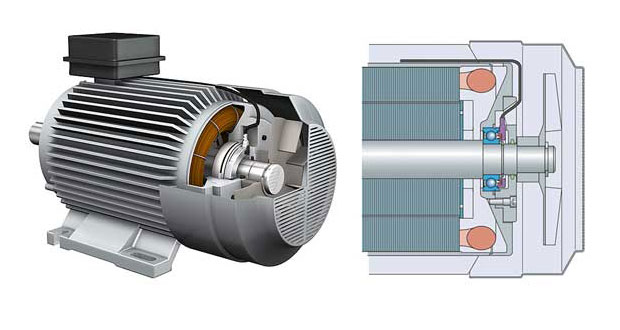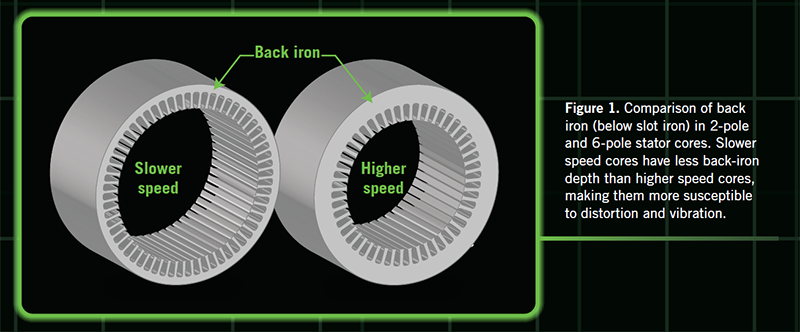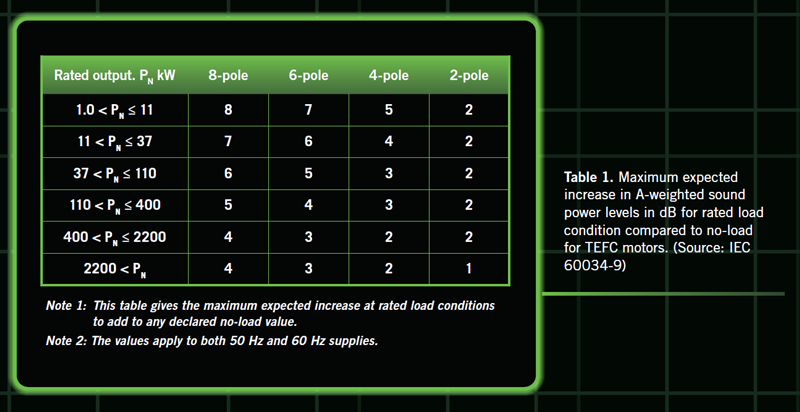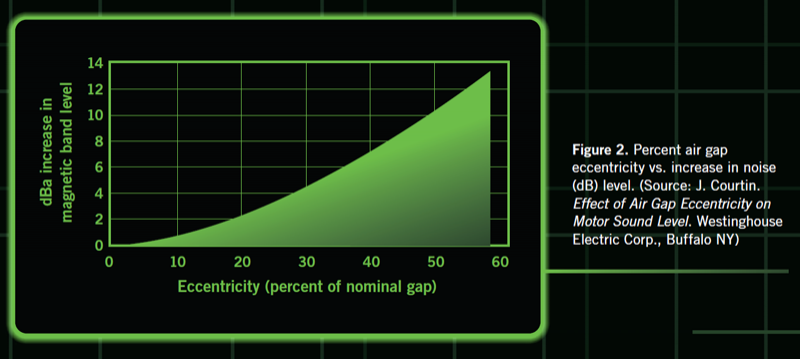Identifying the source of noise in an electric motor is often more challenging than correcting it. A methodical approach to investigation, however, can narrow down the possibilities and make it easier to fix problems—with one caveat. If the noise is caused by something in the motor design (for example, a manufacturing defect or anomaly), a solution may be impossible or impractical. With that in mind, let's review the main sources of motor noise -- magnetic, mechanical, and wind resistance -- along with their causes and ways to reduce or eliminate them.

Magnetic noise
(Note: All noise originates from mechanical forces that transmit pressure waves through air, liquid, or solid materials. Noise frequency components within the human hearing range are typically between 20 Hz and 20 kHz.) Magnetic noise (aka "" "Electromagnetic" or "electrical" noise) is caused by mechanical forces (such as pressure) created by the attractive and repulsive forces of magnetized components in their alternating magnetic fields. The alternating magnetic field excites vibration and noise at twice the line frequency (e.g. humming), but only when the motor is energized. (Hint: If the noise stops immediately after a power outage, its source is magnetic.)
Magnetic noise is usually the second largest noise source for two-pole and four-pole motors (wind resistance is the first), and can be the dominant noise source for six-pole or more-pole motors. This is mainly because the stator back-iron depth of low-speed cores is less than that of high-speed cores with fewer poles, which makes them more prone to deformation and produces larger vibrations with less force. Low-speed motors with six or more poles tend to generate higher noise levels due to the eccentric effects of smaller air gaps and out-of-tolerance bearing and housing fit.
If magnetic noise is its main source, the overall motor noise tends to increase when a load is applied. Generally, the difference in overall noise level at no-load and full-load is small for two- and four-pole motors, but can be significant for motors with six or more poles.

Motor designers manage magnetic noise by making the air gap as large as possible (while maintaining an acceptable power factor). They also reduce the magnetic forces created by air gap variations and generally improve power factor by using longer cores to reduce the air gap flux density.
Another consideration is that closed slots never result in increased magnetic noise, which explains why designers prefer closed slot rotors. They also liked the semi-closed slots with minimal openings for stray winding the stator, even though wider slot openings would make insertion of the windings easier.
portamento. A related form of magnetic noise is sliding noise. This relatively low-volume, low-frequency bouncing of high-frequency components can be objectionable because it is intermittent. As a function of slip, it is more pronounced under load, and the frequency varies directly with slip. Causes can include open rotor bars or end rings, but sliding noise is often associated with a uniformity defect in squirrel-cage rotors, and the remedy for this is to replace the rotor with a new one.
The inclination of the rotor slots reduces magnetic noise, but there is no consensus on the optimal amount or even an accurate way to calculate its effect on the noise produced. A common suggestion is to tilt the rotor, with at least one rotor or stator slot (whichever has fewer slots). Any reduction will not significantly reduce magnetic noise, and larger skew generally degrades motor performance.

Uneven air gap. Unequal air gaps result in an unbalanced magnetic pull and a stronger magnetic force in the direction of the smallest air gap. This deforms the stator, rotor and frame, and generates electromagnetic noise. Running the motor at reduced voltage is a simple diagnostic tool. For example, if the motor is noisy at full voltage but sounds fine at half rated voltage, be concerned about air gaps and issues such as poorly machined housings or eccentric rotors.
The reasons for the uneven air gap are:
Eccentric rotor
Eccentric stator
Bending shaft
journals machined concentrically to the rotor body
Housing (or sleeve bearing) not concentric
The end bracket is not aligned with the stator
twisted frame
Manufacturing variations have a greater impact on magnetic noise for low-speed motors than for two-pole motors. This is because four-pole or more pole motors have a much smaller air gap than two-pole motors, giving them a smaller margin of error. For example, a six-pole motor with a 22" (560mm) OD stator might have an air gap of 0.022" (0.55mm), while a two-pole motor with the same stator size might have an air gap of 0.055" (1.4mm).
mechanical noise
Sources of mechanical noise in electric machines include loose stator cores; worn, damaged, or poorly lubricated bearings; and friction from internal components. Additionally, any structural part of the motor that is excited at its natural frequency can be a source of airborne noise.

BG Motor attaches great importance to the quality and quality of its products, and will conduct repeated inspections at each
stage of motor production to ensure that each motor is in a qualified state when it leaves the factory.
If you have any doubts about the motor noise or have requirements on the motor, you can also contact our BG Motor sales staff at any time, and we will provide professional answers and suggestions as soon as possible.
 BACK
BACK
Yesterday, the 138th China Import and Export Fair (Canton Fair) was grandly open…
In the golden autumn of October, the fruits are fragrant. On this beautiful mome…
Dear friends, the 138th Canton Fair will be held in Pazhou, Guangzhou on October…
At BG Motor, we firmly believe that the strength of a team can carry dreams furt…
New Breakthrough at Conifer (Silicon Valley Startup)What’s new?Conifer has devel…
The 2025 World Robot Conference (WRC), held in Beijing, brought together top min…